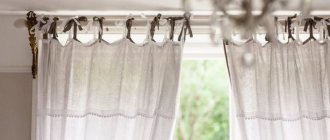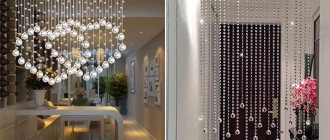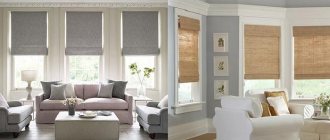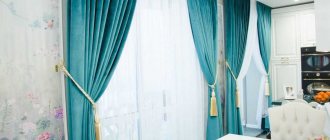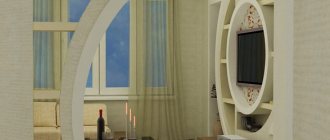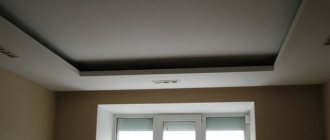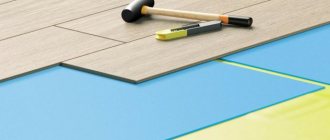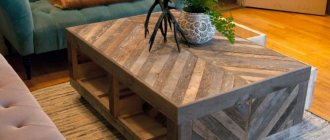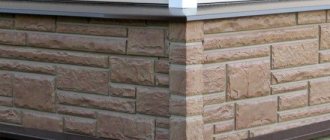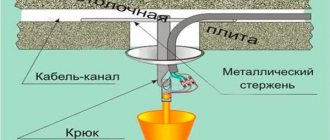How to sew and hang curtains on a ceiling cornice
Ceiling cornices are increasingly winning the hearts of buyers due to their functionality, as well as their ability to visually add height to a room. However, before purchasing such a design, you should think about what kind of curtains or curtains will be hung on it, how many layers, what weight, what kind of fastenings the curtains will have. After all, to get the perfect appearance of the windows, you need not just hang the curtains on the ceiling cornice, but in accordance with all the listed features.
Hanging curtains on the cornice
When hanging curtains on a ceiling cornice, it is necessary to take into account certain factors:
To use hooks for hanging curtains, you need to sew a ribbon with laces (loops) to the curtain.
- room design;
- the number of layers of curtains and the presence of lambrequins;
- method of fastening the cornice;
- cornice shapes;
- weight of curtains.
If the window will be covered simultaneously with decorative, working curtains and tulle, then in this case you should use a three-row cornice. If a lambrequin is expected, then you will need to buy a four-row cornice.
Curtains need to be purchased in such a width that when closing the window they protrude onto the walls on the sides of the window by approximately 20 cm. Thanks to this, they will look very beautiful and can also cover the entire radiator and window sill.
You can attach curtains to the ceiling cornice using the following fasteners:
- "Crocodiles." According to the principle of their operation, they are similar to ordinary clothespins, only because they have teeth, the fixation of curtains is more reliable.
- Hooks and rings. They can come complete with a cornice or separately. In this case, hooks can be used as independent fasteners or in conjunction with rings. The use of this method of attaching curtains requires the presence of loops in them that will be put on hooks. This mount is great for light curtains.
- Kulisok. During the manufacture of curtains, a special pocket is sewn into which the cornice is inserted. This creates the effect of its absence.
- Clip. According to the principle of fastening, clips are similar to “crocodiles”, only they do not have teeth, so it is better to hang light curtains and tulle on them.
- Eyelets. Such fasteners are metal rings that are inserted directly into the curtains. With their help you can easily gather fabric into folds. Grommets can only be used with tubular curtain rods.
- Fabric loops. This fastener has a beautiful and natural look and goes well with round cornices.
Related article: Do-it-yourself film greenhouse: inexpensive and practical
To achieve folds on the curtains, it is necessary to attach the rings at the same distance, equal to approximately 100 mm. If the curtains are attached to clips, they can be alternated with round rings. This will help create a better mount.
How can you hang curtains?
Before deciding on the type of cornices that will be purchased in a particular case, it is worth keeping in mind how window textiles can be attached to them. So, fastening the curtains can be as follows:
- Using curtain tape;
- For decorative hinges;
- With ties;
- For large eyelets;
- On hooks, clips or clips;
- Backstage.
How to choose the right ceiling cornice?
Now it’s worth comparing the chosen option for fastening curtains with the capabilities of cornice structures.
A rod cornice (stick) is a rod mounted on brackets. It is convenient to hang curtains on such a design, which have large eyelets, decorative loops or ties, and drawstrings as fastenings. That is, the bar is threaded directly into the loops (or they are fastened to it if they have Velcro or a decorative button), into the eyelets or drawstring (the latter will completely hide the bar). For example, you can hang thread curtains on the drawstring - they have it structurally provided for. At the ends of such cornices, special end caps are usually placed, sometimes very decorative.
The string cornice is a steel “thread” attached from the sides to special holders. It is only good for windows less than 3 m wide (taking into account the removal of the cornice from the sides). Otherwise, the wire will begin to sag under the weight of the curtain, even if its fabric is thin and light. String models are designed for thin tulles, curtains, and veils. The composition can be multi-layered (then several strings are pulled), but it is unlikely to be made lightproof.
A profile cornice allows you to create multi-layer structures, while the thickness and weight of the fabrics can be large. On such models you can simultaneously hang tulle (perhaps even in 2 layers), curtains and lambrequins. It is convenient to hang Japanese curtain panels or models assembled with curtain braid on such curtain rods (the main fasteners for the profiles are hooks).
When choosing a specific option, it is important to remember that removing curtains from the ceiling cornice should be easy: hooks or clips should be free of roughness, nicks, and distortions. The cornice should provide a comfortable distance not only to hide the ledge of the window sill or radiator, but also to allow the textile sheets to be removed without hindrance. These are the subtleties of calculation before installing the cornice structure.
By the way, in order for the curtains from below to end exactly “at the floor”, it is important to measure the length of the curtains, and then measure this distance not to the cornice, but to the fasteners - hooks, clips, etc.
Hanging curtains on the ceiling cornice
The choice and method of hanging curtains is made based on the following factors:
- The number of layers of textiles expected to be hung, as well as the presence or absence of lambrequins among them.
- General style of the room.
- The massiveness of hanging textiles.
- Shapes of installed cornice.
- The method of installing the cornice is to the ceiling or to the wall.
With all this, curtains are divided into:
- Workers closing at night and opening during the day.
- Decorative, serving as decoration both when the curtains are open and when they are drawn.
Work curtains have a higher density and are used for hanging in bedrooms
If it is assumed that the window will be covered simultaneously with tulle, working and decorative curtains, then they, accordingly, must be hung on a three-row cornice. If this additionally involves installing a lambrequin, then a cornice with four rows will be required.
Correctly select curtains of such a width that when they cover the window, the protrusion of the curtains on the walls on the sides of the window is 15-20 cm. In this case, the curtains will look most attractive and will cover the edges of the radiators and window sill .
Advice! Before hanging curtains on the curtain rod, make sure that it is shorter in length compared to the height of the room. If you neglect this rule, then curtains hung on such a cornice will visually make the room lower and less comfortable.
How and with what to attach curtains to the cornice
You can hang curtains on a ceiling cornice using the following types of fasteners:
Rings with hooks for attaching curtains to the curtain rod are one of the most popular types of parts for hanging curtains
- Hooks and rings. They can be sold complete with a cornice or separately from it. In addition, hooks can be used as an independent fastening unit, or they can “work” in conjunction with rings. This method requires sewing loops to the curtains, which are actually put on the hooks. Hooks are ideal for hanging lightweight curtains .
- "Crocodiles." Crocodiles work on the principle of clothespins, only their fastening is more reliable due to the presence of teeth (see below: Ceiling cornice with lighting).
- Eyelets. This type of curtain fastener is a set of metal rings inserted directly into the curtain fabric. Allows you to automatically gather curtain fabric into folds . Requires preliminary making of holes in curtains and filing of holes. Eyelets only fit tubular cornices.
Inserting a grommet into a curtain can be done using a hammer
- Clip. The principle of operation of clips is similar to the method of fastening with alligator clips, but they do not have teeth. Suitable for attaching tulle and light curtains.
- Fabric loops. Fabric loops look original and at the same time natural when decorating country-style rooms, kitchens and go well with round cornices . The material for cutting the loops is usually the same from which the curtains themselves are made.
- Kulisok. When sewing curtains, a special pocket is provided for placing on the cornice with a frill on top. In this case, the drawn curtains will completely cover the cornice and create the impression that it does not exist at all.
How to sew and hang window textiles beautifully?
Choosing a suitable pair of cornice-curtains does not always mean ensuring the beauty and neat appearance of the window. Hinges, drawstrings or eyelets will do their job by default. But what to do if the textiles are attached to clips or hooks? You will need to distribute it evenly between these fasteners so that nothing sag and the fabric drapes evenly. How to do it?
If the housewife has sewing experience, it is best, of course, to sew curtains for the ceiling cornice yourself. This is cheaper and will allow you to realize any idea. With this approach, there will be no difficulties in designing the desired drapery. The simplest and most convenient option is to attach curtain tape to the top edge of the curtains. It will ensure uniform assembly without sagging: by pulling the special threads of the tape, the fabric is pulled to the desired width.
Or you can lay uniform folds (preferably counter pleats) across the entire width of the curtain and stitch them. If novice needlewomen have any difficulties with sewing, you can find and watch an appropriate training video, and then follow the advice received.
But in general terms, sewing window textiles in the simplest version will not cause any particular difficulties. You need to measure the correct length (see above), add to it an allowance for processing the top with tape, set the required gathering factor in the width of the canvas (the degree of pomp of the curtains depends on it), taking into account the protrusions of the cornice beyond the edges of the window.
After cutting, sew the side and bottom edges with a hem seam, and decorate the top edge with curtain tape, folding the edge. It is only important to take into account that the length of such curtains will be longer than for mounting on a regular wall cornice, since the latter is always located slightly lower. To properly hang window textiles on ceiling cornices, you need to take this nuance into account. Otherwise, the window will look like it has been “shot.”
More complex curtain models - with draped parts, linings, etc. are not recommended for sewing beginners, since there is a high risk of mistakes.
What about curtains? They are sewn according to the same pattern as curtains. But if the cornice does not require the presence of a decorative panel behind which the fasteners can be hidden, then it will not be possible to place a curtain fabric on the curtain tape: the tape will show through the thin material unattractively. There is another mounting option here. You need to tuck the canvas a few centimeters from the sides and secure it with a clamp or clip.
Then find the middle of the piece and secure it with a small fold using a middle clamp or clip (their number should be odd for this). Next, the left and right parts are secured step by step according to the same principle: find the middle clamp and use it to fix a small fold in the center. This is done until all fasteners are engaged. This method requires a good eye.
Advice: When sewing, it is better for inexperienced dressmakers to avoid not only complex patterns, but also fabrics that are difficult to process: loose, too elastic (distortions will inevitably occur), too textured (the seams will be rough) or thin (they “move” during processing, so cutting and sewing them neatly won’t work either).
Hanging curtains on the ceiling cornice
The choice of how to hang curtains on a ceiling cornice depends on the overall style of interior design and on the number of layers of fabric from which the curtains on window and doorways are made. The easiest way to hang: transparent tulle and thick curtains. Such curtains are appropriate in different rooms and are always popular, but they also need to be hung correctly. Only then will the textile frame of the window serve as a decoration for the room.
Window decoration with curtains on the ceiling cornice
Why choose ceiling cornices? Firstly, with the help of curtains hanging on the ceiling cornice, you can beautifully drape the surface of a wall or window. Secondly, such curtains cover all defects of the window opening and the window itself. And finally, thirdly, floor-to-ceiling curtains cover the entire window, leaving no gaps. Therefore, the choice of curtains is very important - they should match the decoration of the room, the curtain rod and be beautiful enough to become another striking black room.
Ceiling cornice is becoming increasingly popular in the market of building materials for the home and this is not surprising, because thanks to the ceiling cornice you can greatly decorate any room.
Installation of ceiling cornice
On the home goods market you can find different types of ceiling cornices. They differ greatly from each other both in the method of fastening and in appearance. Among the options for hanging curtains are the following:
- A stick cornice consists of brackets and a rod resting on them. This option is convenient for curtains that have decorative loops, large eyelets that serve as part of the design, or a drawstring that decorates the top of the panel. The ends of the rod are usually fitted with metal or wood tips. These details can be additional decorative elements. Ceiling cornices are appropriate in a classic or Victorian setting and harmonize well with any rustic style.
- Profile varieties allow you to conveniently hang multi-layer curtains: with lambrequins, with additional decorative curtains and ties. The compactness of such products allows you to place up to 4 layers of fabric. This type is very convenient for Japanese curtains and curtains with braid. Suitable for almost any style that requires multi-layer curtains with fixed and moving panels. Thanks to the tips in the form of arcs, it allows you to close the window from the sides. A new product - a flexible curtain rod - allows you to hang curtains comfortably and in an original way to zone a room.
- The string, or string cornice, is inconspicuous. It consists of side fastenings and a thin steel wire stretched between them, along which the curtain moves. The strings can be stretched in several rows to make a beautiful multi-layered curtain. The disadvantage of such curtain rods is that if the length is more than 3 m, the wire sags under the weight of the fabric. String curtain rods are very convenient for thin transparent fabrics: the wire is invisible and does not create the illusion of a low ceiling.
Before hanging curtains, any type of curtain rod must be attached to the ceiling. To do this, you need to prepare the following tools:
- perforator;
- screwdriver;
- measuring instruments;
- plumb line
The length of the cornice for ready-made curtains is selected depending on their width and the owner’s desire to add folds to the curtains. It should also be based on the size of the window or door: the side sections of the curtains are best positioned so that they cover the wall near the window or door frames by 10-15 cm.
The distance from the window on which the curtain will hang must be calculated so that the panel does not interfere with opening the sash, does not touch the plants on the windowsill and is located no closer than 5-7 cm to the heating devices installed near the window.
The width measurements must be transferred to the ceiling and marked. From the straight line drawn between them, lower the plumb line and estimate the distance at which it is located in relation to the central heating convector or plants. If necessary, move the width marks a little further from the window.
Based on these points, you need to install brackets or attach the runners of the profile cornice. For installation, dowels and screws are used, which are included in the kit of each product in the required quantity. Using a hammer drill, you need to make holes that correspond to the fastenings in the bracket or profile. To do this, the part should be positioned so that the straight line marked on the ceiling coincides with the outermost string, rod or track on the profile, then make marks by inserting a pencil or nail into the fastener.
Drill holes for the dowels and insert plastic capsules into them. Attach the bracket to the ceiling and screw the screws into the holes. After installing the curtain rod, you can proceed to hanging curtains.
Attaching curtains to ceiling cornices
Before attaching curtains to the curtain rod, it is necessary to analyze some points:
- design and style of the room;
- method of fastening the cornice;
- number of layers of fabric and the presence of lambrequins;
- weight of curtains;
- cornice shape.
Most often, curtains are attached to the cornice using hooks.
The curtains need to be selected in such a width that they protrude beyond the edges of the window by at least 15/20 cm, in this case they will look more attractive and cover the window sill and radiator. Depending on the type of curtains, a two-row, three-row or four-row cornice is selected.
There are the following types of fastening curtains to the cornice:
- hooks and rings - these are best suited for light curtains;
- eyelets are metal rings that are inserted into the fabric and allow curtains to be automatically folded;
- “crocodiles” - function as clothespins, and the presence of teeth contributes to the strong fastening of curtains;
- fabric loops - made from the same fabric as the curtains;
- clips - similar to “crocodiles”, but do not have teeth;
- Drawstrings are special pockets for putting on curtains, with a frill on top that allows you to completely close the cornice.
Once the type of fastener has been selected, you can begin hanging the curtains on the cornice. Each fastening element is quite convenient to use and can be easily attached to the curtains, after which it must be inserted into the guide grooves. If you need to get beautiful folds on the curtains, then the fastening parts are placed at the same distance from each other, approximately 10 cm.
How to hang curtains?
All layers of textiles that make up the window frame are divided into:
- transparent - tulle, organza, thread and other varieties that do not create an obstacle to light and remain in place constantly;
- workers - thick curtains that move, opening or closing the window opening;
- decorative - various additions to the top and sides of a window or door opening, usually fixed.
Everything together forms a multi-layered ensemble, which is called a curtain. Hanging methods depend on the overall style of the room, but most pieces can be used in different interiors.
These are decorative loops that are often sewn onto work panels. They are appropriate in a rustic, austere Victorian setting, and in a classic design, if lambrequins covering the top of the opening are not used. For this method of suspension, a thick rod with expressive tips is best suited. You can decorate the places where the loops are sewn to the panel with a bright button or bows. The rod is threaded directly through the fabric loops.
For modern styles (hi-tech, minimalism, etc.) you can make curtains with eyelets. Metal or plastic rings are installed directly in the panel, along its upper border. You can hang such a curtain on a rod or string.
The most convenient thing about curtains with grommets is that they easily fall into beautiful, even folds.
Hanging curtains on the ceiling cornice
There are many ways to hang curtains, we will consider these methods based on the following factors:
- How many layers of textile are included in the canopy and how many lambrequins are present on them.
- The style of the room and its design are taken into account.
- It is also necessary to take into account the total weight of the textile.
- The shape of the mounted cornice.
- The method of attaching the cornice is to the ceiling or to the wall.
It is worth noting that curtains are conventionally divided into:
- Workers , that is, those that open during the day and close at night.
- Decorative . The curtain serves as a decoration for the room.
If the owners decide to hang three types of curtains at the same time - tulle, working and decorative, then they will have to install a three-row cornice for each type of curtains separately. To install an additional lambrequin element, you will need a four-row cornice.
The width and length of the curtains are selected according to the following recommendations: the protrusion from the sides to the walls from the window should be at least 15-20 centimeters. Such requirements are not accidental, because curtains must cover the edges of the window sill and fit harmoniously into the overall picture.
ADVICE! Before starting the process of installing the cornice, you must make sure that its length is less than the height of the room. Ignoring this recommendation will lead to the fact that a large cornice will visually make the room smaller. And huge curtains, in accordance with the size of the cornice, will make the room less cozy.
How to beautifully drape a panel?
In order for the curtain panels to form beautiful folds, you need to know how to properly hang the curtains on the cornice. The stick and string devices have rings and clips for this purpose, and the profile one is equipped with hooks. The curtains are attached to the curtain rods using these elements: the hooks can be inserted into the loops, and the clips and rings are equipped with clamps.
But in order for the curtain to lie in even waves, it is not enough to simply attach it to the cornice. Folds need to be laid either when sewing or when hanging curtains from the ceiling. In order to make a wave or gather when sewing, take 1.5-2 times more material than required by width measurements. You can make drapery when sewing like this:
Types of cornices
- In the form of a barbell. They are attached to the wall using brackets. They consist of several guides on which tulle or curtains are hung. The material of the blades is connected to rings that move freely along the rod.
- Cornice-string. Used for light fabrics such as organza. Heavy material may cause sagging.
- Baguettes. They are a plank made of wood, covered with plastic tape.
- Profile. They consist of a structure into which runners are inserted. The place where such cornices are attached can be a wall or ceiling.
- Flexible. Made from polymer-metal material. They are highly flexible.
- Telescopic. There are times when it is impossible to install fasteners to the wall. In this case, the cornice expands between the walls using springs built into the rod.
Types of ceiling cornices
Today there are several types of ceiling cornices. Their choice is influenced by the multi-layered drapery, fabric density, stylistic unity, and type of ceiling. It can be:
- Strings. Having chosen such a model, do not forget to provide another fastening in the middle so that the wire does not sag under the weight of the canvas.
- Profile. Such curtain rods can be either plastic (maximum length 3 meters) or metal (up to 6 meters long). A distinctive feature of this design is the possibility of rounding, which makes them indispensable when designing window openings of non-standard shapes.
- Baguettes. They are made of natural wood and are an expressive detail not only in the decoration of the window, but also in the entire interior. They are designed for increased load.
All that remains is to determine which curtains can be attached to each of these curtain rods.
Ceiling cornice and suspended ceiling complement each other perfectly.
This design creates the feeling that the curtains are flowing directly from the ceiling.
The cornice itself is installed in a niche and is completely invisible behind the suspended ceiling.
Types of curtain fastening
Some types of curtain fastenings are hidden, while others, on the contrary, stand in plain sight and have a beautiful appearance. Curtain hangers are:
- In the form of rings that easily slide along the bar, they are attached to the material with loops.
- Hooks. The upper part of the hook hooks onto the guides, and the lower part onto the loops.
- Loops that are sewn to the curtain material and placed on a round cornice.
- Eyelets. They are built into the fabric and placed on a round cornice.
How to hang curtains correctly
Making curtains on a window is a process that requires taking into account factors such as:
- Window dimensions.
- Furnishing style.
- The type of cornice used.
- Fabric, its density and quality.
With the help of a curtain it is easy to visually modify the living space in one direction or another. It must be remembered that the distance between the fastenings of the material to the cornice should be as small as possible. Then the material will lie smoothly and beautifully.
There are tricks on how to hang curtains correctly to give the living room comfort and originality:
- Asymmetrical, when a longer curtain is placed on one side of the window.
- Mirror symmetry relative to the center line of the window.
- There is a curtain in the center of the window, and the other two form symmetry relative to it.
- Complex arrangement of curtains with all kinds of tiebacks and draperies.
- It is advisable to accompany any curtains with tiebacks in the form of pearls or metal.
- Use wide tiebacks, and the material should be the same as in the curtain.
- Get creative with loops, make them in the form of eyelets or bows.
- Decorate the folds of the curtain with all sorts of trinkets.
- Use beautiful fittings.
Tips and tricks on how to hang curtains on a ceiling cornice correctly
Ceiling cornice with curtains
Correctly selected curtains and hung on the ceiling cornice can become a real decoration of any room, as well as provide reliable protection for your sleep from the rays of the morning sun. In order for the curtains to look beautiful and at the same time be functional, you should understand in more detail how to properly hang the curtain rod and curtains on it.

